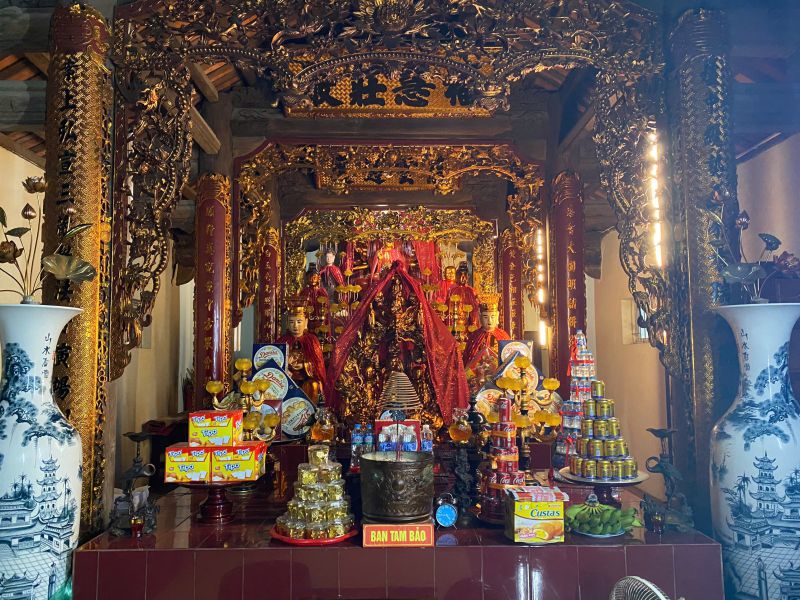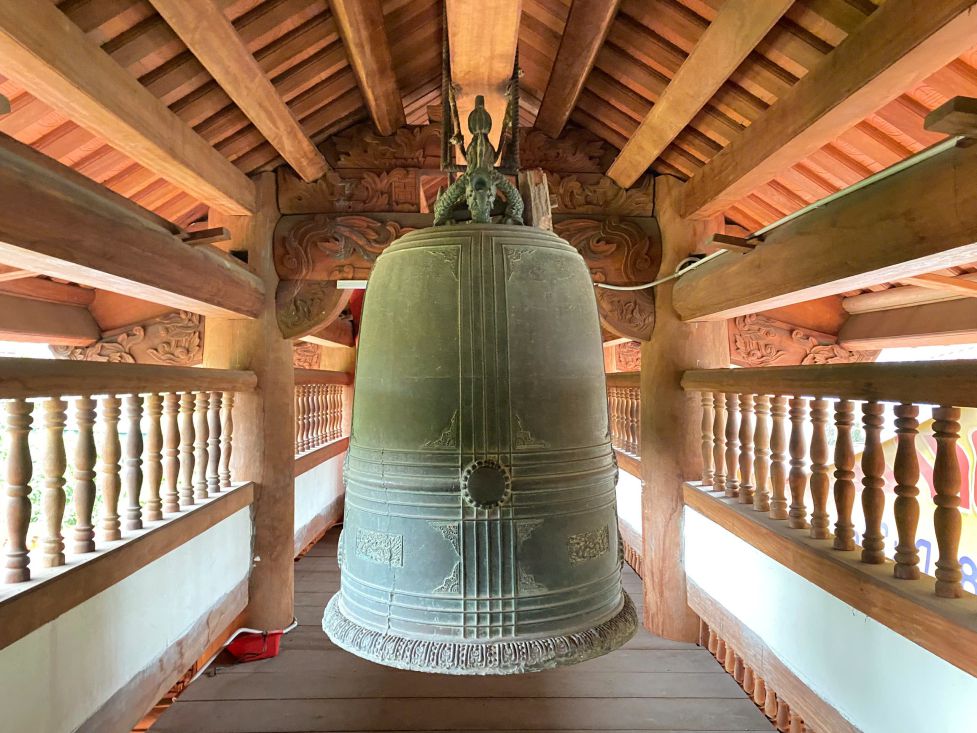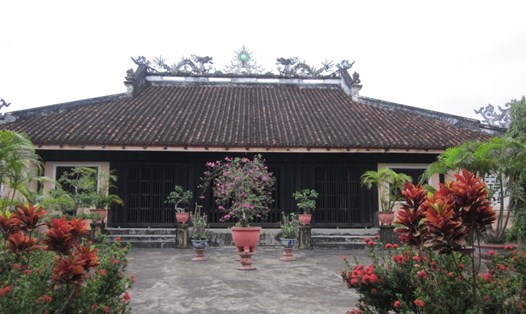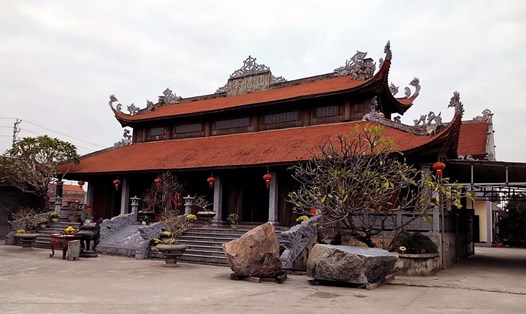The ancient temple of the ancient land of Doai
In the past, because it was the pagoda of Yen Lung commune, including 6 communes: Yen Lung, Van Lung, Yen Tho, La Phu, La Duong, Ngai Cau, the pagoda had a large scale in the region. The pagoda faces the South, currently the overall worship architecture of the pagoda includes: Tam Quan (bell tower), Tien Duong (T-shaped architecture), Thanh house, and finally the ancestor house and the mother house. The architectures are located in a straight line along a North - South axis. To the East is the tower garden area, where the bodies of the abbots of the pagoda are kept when they pass away; to the West is the monk's house area, where monks and nuns practice at the pagoda.
Surprisingly, the pagoda still has many traces from the Ly Dynasty to the Nguyen Dynasty. According to researcher Do Hoang Tuan in the book "New discoveries in Archaeology in 1993", there are still some sandstone foundations that many researchers have long recognized as dating from the Ly Dynasty. These stone foundations are similar to the foundations of Thanh Than Pagoda (Thanh Oai, Hanoi) or Thay Pagoda (Quoc Oai, Hanoi). Many traces date from the late 16th to early 17th century, which are the dragon-shaped heads with a style similar to Tay Dang communal house (Ba Vi, Hanoi), Tuong Phien communal house (Phuc Tho, Hanoi), Lo Hanh communal house (Hiep Hoa, Bac Giang), specifically: fierce dragon face, wolf mouth, animal ears, deer horns, camel forehead, especially the thin wavy and elongated knives. In addition, on the entrance doors there are also some dragon and unicorn carvings dating from this period. After that, the pagoda was restored many times, typically in the second year of Gia Long (1803).
According to legend, this pagoda was once worshiped by the local people who brought the Phap Van descendant from Dau Pagoda in Bac Ninh. Today, the Phap Van statue is still worshiped in the front hall. Therefore, the pagoda has the phenomenon of "Buddha first, Saint later", but these two worship systems are clearly separated. The front area includes the Front Hall and the Upper Hall, forming a "T" shape to worship Buddha. Behind are the Great Worship Hall and the Rear Palace, forming a "Nhi" shape to worship Saints. These two worship areas are separated by a small courtyard.

A place to preserve the legacy of our ancestors
The pagoda still preserves dozens of ancient statues, 9 ancient royal decrees, bells and bronze gongs with typical and unique beauty of the 16th - 17th centuries. A typical example is the Quan Am Chuan De statue with 21 pairs of hands forming many different mudras, the statue is 1.38m high and is placed on a 0.28m high lotus throne. The Buddha statue sitting on a lotus throne is carried by a lion, the statue has a unique feature with the right hand with the index and middle fingers pointing to the sky, this image is similar to the Buddha holding a flower and the Buddha preaching; including the pedestal, the height is 1.48m, the Buddha statue is 0.85m high. This is a very rare and precious Buddha statue in Vietnamese Buddhism art, because until the 17th century, lions holding lotus thrones were rarely seen in worship statues. In addition, there are also two statues of Kim Dong and Ngoc Nu, up to 1.55m high, with unique and meticulous decorative patterns.
The Ca Pagoda still preserves a bronze gong, 136cm wide, 88cm high, 3cm thick, cast by the people of the commune in the 6th year of Canh Hung (1745). On the surface of the gong are carved the Chinese characters: Phuc Lam Vien, Dai Bi Tu, Tu Linh Bao Khanh cast in the 6th year of Canh Hung, the year of At Suu (1745). On both sides of the gong are unique and sophisticated decorative patterns with the theme of the four sacred animals (dragon - unicorn - turtle - phoenix), one of the themes expressing sacredness, nobility and luck. According to the book "The World of Symbols in Cultural Heritage", the Ca Pagoda bronze gong depicts the four sacred animals created together in a decorative space, which is considered the earliest. After this time, bronze gongs were also found in many places, such as at Thay Pagoda (Hanoi), Dai Pagoda (Ha Nam)...

Interesting story about temple bells
The people of the old Xu Doai region have a proverb "Ke Song bell, Ke La tube, Ke Nga wooden fish, Cau Ngai cake" or "Nhat bell Ke Song" to mention the popularity of the bell that is still preserved at the Ca pagoda. Under the reign of King Le Kinh Tong, in the 14th year of Hoang Dinh (1613), the people of Ke Song cast a bronze bell together. The bell has the following specific dimensions: The bell is 1.29m high; the bell diameter is 0.73m; the bell is 0.04m thick. The Ke Song bell is one of the largest and earliest in Vietnam. The bell handle is shaped like a dragon, very sophisticated, the bell face includes 6 bell knobs, of which 4 knobs are symmetrically created, the bottom of the bell face is shaped like 4 dragons lying symmetrically, the top of the bell face is engraved with 4 inscriptions on 4 sides. In particular, on the bell face there is full information about the pagoda and the year the bell was created, Phuc Lam Vien, Dai Phuc Tu, Hong Tru created, Tich Co Chung, Hoang Dinh Van Nien Chi Thap Tu, Quy Suu May So Thap Nhat created the Hong Tru bell.
Since ancient times, the people of Van Lung village have passed on to each other the story of casting the Ke Song bell. One day, the people of Van Lung village opened the donation box, and the villagers together contributed and donated to cast the bell. When the donation box was opened, a beggar passed by and also had the Bodhi mind to contribute a coin to cast the bell. The village chief of Van Lung village saw this and felt offended, so he threw it back at the beggar. When the bronze bell was finished, a small piece was missing, the village had it recast many times but each time a piece was missing. Seeing this strange thing, the village decided to hang the missing bell in the pagoda. When the Dai Phuc temple bell rang, the sound of the bell echoed throughout the four worlds, even though it was dozens of miles away, the sound of the bell reached the capital. The sound of the bell seemed to cut into people's hearts, the king saw something strange, and sent soldiers to find the origin of the bell sound; when the soldiers returned to the village, they heard the story and reported to the king. When the king heard the story, he ordered the removal of the village chief of Van Lung village.
On the 8th day of the 4th lunar month every year, the people of Ke Song joyfully hold the festival at the Ca Pagoda, that is why there is a folk song: "Remember the 8th day of the 4th lunar month, if you don't go to the Song festival, you will lose your life". Not only the villagers go to the festival, but people from all over the region come to the Ca Pagoda every 8th day of the 4th lunar month to attend the festival. The Ca Pagoda festival has truly become a festival for all the people in the region.
Because of its outstanding values, in 1996, the Ministry of Culture and Information, now the Ministry of Culture, Sports and Tourism, ranked Ca Pagoda (Dai Phuc Tu) as a National Architectural and Artistic Relic.










